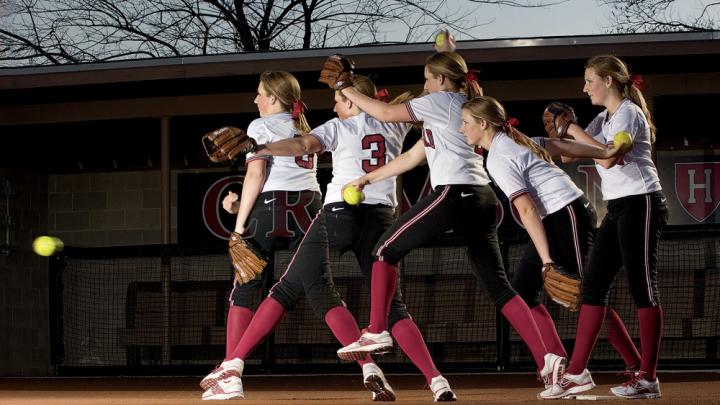The fact that a softball diamond is so much smaller than a baseball field has radical effects. It means a faster game, for one thing. Softball bases are 60 feet apart, not 90, making for a much quicker trip between them. In baseball, a batter usually has to hit the ball into the outfield to make a single. In softball, though, even with bases empty, you’ll often see third basemen playing well in to defend against a bunt. That’s because bunts, cue shots, Baltimore chops, little nubbers, and other infield hits are all promising ways to reach first, especially with a speedy runner at the plate. “About 80 percent of the teams have a ‘slapper’ for a leadoff hitter,” says Harvard pitching ace Rachel Brown ’12. “If you have a girl who can barely touch the ball, but can beat the throw to first base, that’s a huge asset. Softball is about moving runners up and manufacturing runs.”
In contrast to one classic baseball formula, “a bloop and a blast”—a fluke hit followed by a long ball—look in softball for an infield single, a bunt that moves the runner to second, then a run-scoring line drive into the outfield. The first line of defense, naturally, is keeping runners off the bases, and few do this better than Brown, whose strategy is simply striking them out in vast numbers. Last year she set a new Ivy League record for strikeouts in a season (299, eclipsing the 258 fanned by Princeton’s Erin Snyder in 2006), while posting Crimson records for strikeouts per game (11.4, with seven-inning games) and wins (21, bettering the 18 victories Tasha Cupp ’98 recorded in 1997; Brown’s record was 21-7). She also led the Ivies in earned-run average (1.90) and opponents’ batting average (.181). To no one’s great surprise, she was the unanimous choice for Ivy League Pitcher of the Year and chosen for the all-Ivy first team from Harvard’s Ivy League-champion squad.
Power pitchers in the big leagues throw fastballs in the 90-plus-miles-per-hour range, with the hardest throwers topping out around 100 mph. In softball, pitching underhand, the fastballers work in the 60-plus-mph range, topping out around 70. But again, the smaller dimensions of the softball diamond factor in. In baseball, the pitching rubber is 60 feet, six inches from home plate; in softball, it is only 43 feet away, so the batter’s reaction time is far briefer: a 65-mph fastball may look like a 95-mph heater would in hardball. Although Brown notes that “every pitch is a variation on the fastball,” and she warms up by throwing fastballs, she says, “I can’t remember the last fastball I threw in a game. Mine doesn’t move—it’s too straight.”
Indeed, there isn’t much that’s straight about Brown’s pitches. One of her lethal weapons is the rise ball, which doesn’t exist in hardball. Thrown fast, with tremendous backspin, the pitch counteracts gravity to some degree and rises as it reaches the plate. Brown has superb control and can locate her rise in different parts of the strike zone. “There aren’t too many, across the country, who can throw a low rise,” says head softball coach Jenny Allard, but Brown can fire a rise ball at the knees that breaks up a few inches into the strike zone—and above the bat of a swinging hitter. Her other “out” pitch is a baffling change-up that comes in at around 45 mph but is delivered with a motion identical to her other pitches. “It’s very hard to read as it comes out of her hand,” Allard says. “Very deceiving.”
Swing-and-miss strikes are the result—Brown’s K’s (the scoring symbol for strikeout) generally come not from called strikes, but flailing batters. “My strength is keeping the hitter off-balance,” the psychology concentrator explains. “I’m comfortable throwing any pitch [she also has a dropping curve and a screwball] for a strike—I’ll throw a change on a full count. The trick is to make balls look like strikes and strikes look like balls. The main goal is to trick the batter.” Allard, now in her eighteenth season at Harvard, adds, “Rachel is so effective at zoning in on a hitter’s weakness—with one swing, she knows where she needs to put the ball. She’s the craftiest pitcher I’ve ever coached.”
Brown honed her craft in southern California, where year-round sunny weather and an intense softball culture combine to create the country’s premier incubator of talent in the game. She began pitching at age eight, played ball “every month except December” with high-school and club teams, and as a senior at Scripps Ranch High School set a new San Diego record with 400 strikeouts. She and younger sister Meredith, a freshman pitcher for Princeton’s softball team, might have faced each other when the Crimson met the Tigers, an historic rival, on March 31; instead, Rachel won the first game, 6-5, whiffing 12, while Meredith pitched two innings of relief in the nightcap, an 8-0 rout by Harvard.
Either sister might have thrown in both games. The underhand motion stresses the shoulder and arm far less than overhand pitching, so the recovery period is much shorter; Brown has often started the first game of a doubleheader and pitched some innings of relief in the nightcap. And she will keep on pitching this summer: a day after Commencement, she’ll fly to Sweden to play for four months for the Skövde Saints, one of five semipro softball teams in that country. She might feel right at home there: last year the Saints, like Harvard, were league champions.









